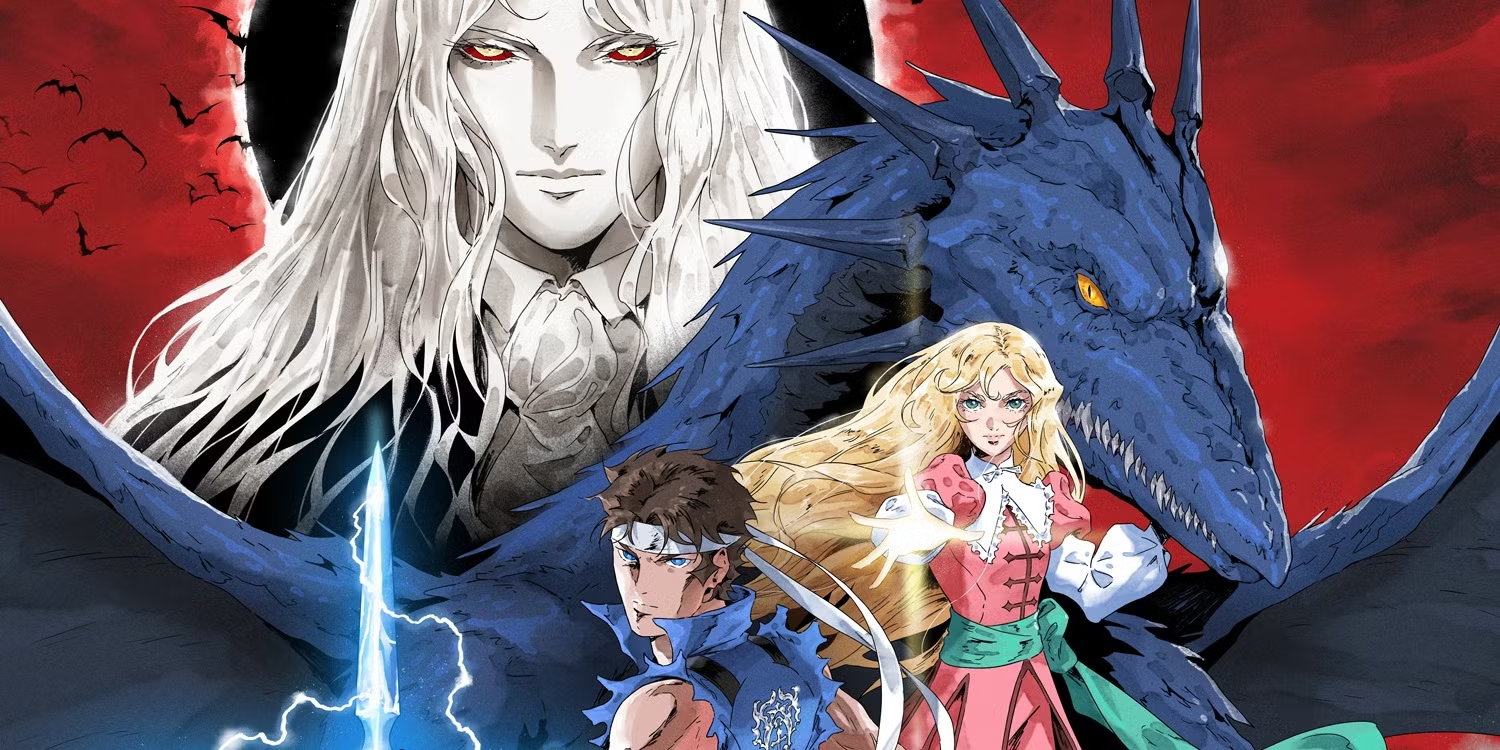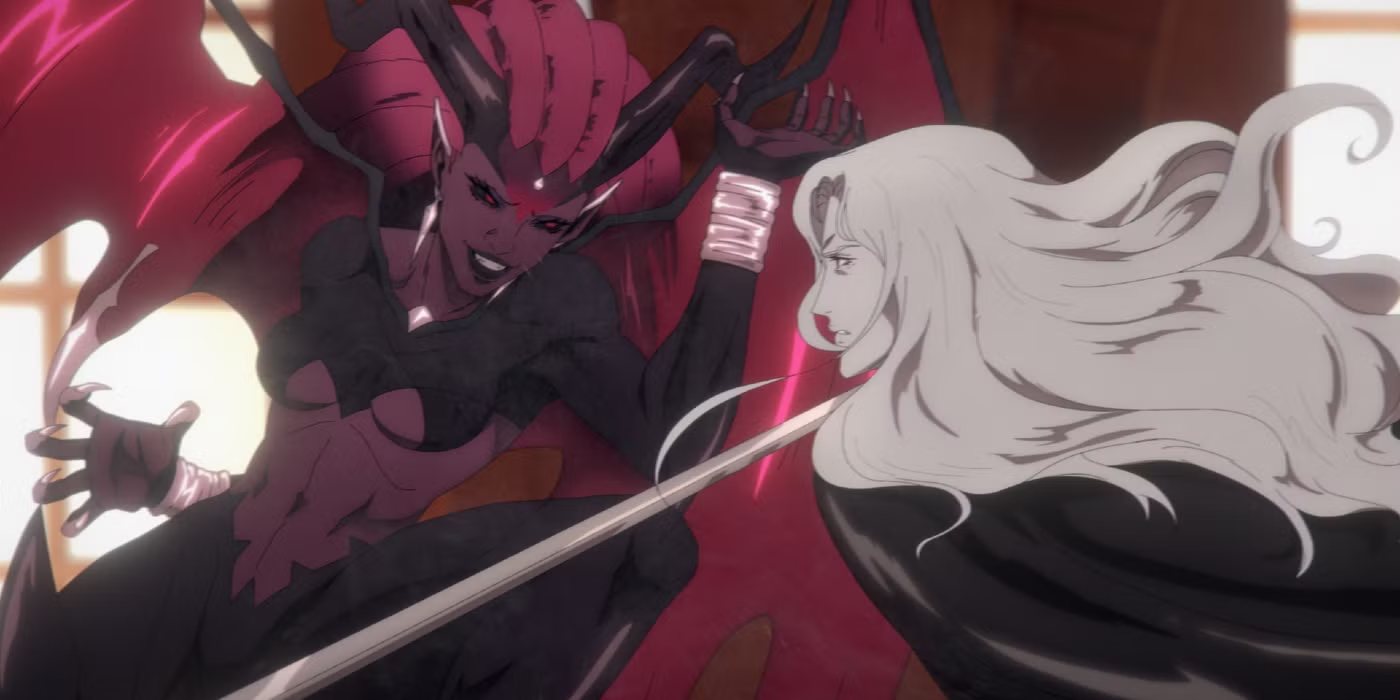Still Got It: Castlevania: Nocturne Season 2 Review
So there’s this show you might’ve heard of. It’s a beautifully animated Netflix original series that’s based on a pretty popular video game franchise. No, it’s not the one you’re thinking of. I’m talking about Castlevania (2017), and its sequel show, Castlevania: Nocturne (2023). Nocturne has returned this January with its second season, bringing with it more vampire hunting action with gaming icons Alucard and Richter Belmont. Being the 6th total season in Netflix’s Castlevania saga, it comes with some lofty expectations, but does this sophomore season of a sophomore show live up to them?
The Castlevania games and series follow the Belmont clan, a family of vampire hunters that pass down their skills and weapons generation by generation. The original show saw the defeat of Dracula by Trevor Belmont (Richard Armitage) alongside a sorceress named Sypha (Alejandra Reynoso) and Dracula’s son, Alucard (James Callis). Nocturne, which takes place nearly 300 years later during the French Revolution, sees Richter Belmont (Edward Bluemel) take on a growing vampire cult worshiping the Egyptian goddess Sekhmet reborn. He’s joined by a found family of vampire hunters, his long lost grandfather, Juste Belmont (Iain Glen), and in the final moments of season 1, Alucard.
Here’s my spoiler free review of season 2: it’s an improvement on the previous one in nearly every way. The characters are better fleshed out, the dialogue is tighter, the action is cranked up past 11, and the animation has reached new heights for the series. I recommend this show to anyone down for a bloody good time fighting vampires, and Nocturne especially for one looking for a jumping-on point.
Spoilers Below

The first thing deserving of discussion is this show’s animation. Castlevania’s style is smooth and sharp, but it comes with a gothic beauty. I’ve noticed this season that each character feels lovingly rendered, their features more crisp and distinct than before. Alucard is especially ethereal, as he is almost entirely monochrome besides his bewitching golden eyes. Castlevania is also known for its flashy, kinetic fight scenes, and Nocturne does not disappoint. The final two episodes are almost nonstop action, with magic, vampires, dragons, and demons all clashing on a Parisian battleground. Richter’s choreography is the show’s triumph. He uses his elemental magic to spin and zip around, sending flying kicks in all directions while covered in ice and fire and electricity.
Outside of combat, the show is awash with beautiful landscapes filled in with rich, vibrant colors, setting it apart from the muted, grounded palette of the original series. Nocturne’s French setting, coupled with themes about making the most of life, inform its brighter, fuller aesthetic. The series’ character designs are another notch on its belt. Most remain the same as the first season’s, but Juste’s Belmont regalia iterates on his outfit from Castlevania: Harmony of Dissonance (2002), and Richter eventually comes to wear this outfit from Rondo of Blood (1993). Each character has their own unique style and color scheme without feeling too color coded, and even background vampires and monster mini-bosses are intentionally designed.

In terms of writing, my expectations were high. Nocturne’s first season, despite being visually stunning, disappoints in the writing department. The original series carried with it the swagger of a show with no limits with language, sex, and gore, but also earned that confidence by having a large cast of fascinating characters and a grand, engaging plot. Nocturne, however, struggled to define its glut of main characters, indulged in tropey, frustrating conflicts, and failed to gain momentum with its plot before the final episode. Thankfully, its second season remedies this.
Like its predecessor, this show’s best resource is its characters. Smartly, its big group of heroes was divided in two, one going to Paris and one staying in Machecoul, the home base of the cult run by the show’s big bad, Erszebeth Bathory (Franka Potente), the “Vampire Messiah” and avatar of Sekhmet. The Paris crew is Richter, Alucard, and Annette (Thesu Mbedo), a Haitian-Caribbean freedom fighter who can control rock and metal, and they comprise the main plot of finding Sekhmet’s mummy, which Bathory needs to attain full godhood. They evoke the original team makeup of Trevor, Sypha, and Alucard from the old days. The Marcheol crew is composed of Juste Belmont and Richter’s adoptive sister, Maria (Pixie Davies), who seeks revenge for Bathory turning her mother, Tera (Nastassja Kinski) into a vampire.
Overall, this season is paced and plotted much better than the previous one. These characters, their actions, and most importantly, their consequences, have time to breathe. The Paris plot is a bit truncated, and it would have stood to benefit from more interaction between Richter and Alucard, but makes up for it with major development for Annette and pulling off her and Richter’s romance, which I found quite sweet.
Where the show really proves itself is in the Marcheol plot with Juste and Maria. Juste was one of my favorite parts of season 1, despite him making only a small appearance. He remains one of the best realized characters in this cast, and his air of regret and sorrow lends so much credence to Maria’s narrative about power and revenge. Iain Glen’s voice work is understated, but powerful. You can feel the years in his soft voice, broken down by decades of conflict. Pairing him with Maria, a revolutionary firebrand now consumed with vengeance, (with vampire Tera thrown into the mix), brings the most interesting qualities out of all characters involved.
This also follows up on the big twist of last season that Macheceol’s priest was not only creating monstrous soldiers called Night Creatures for Bathory, but was also Maria’s father. The Abbot (Richard Dormer) was, by far, the first season’s best character. He sees the Revolution as a threat to the church, so he partners with vampires to stamp it out, all the while working against his very own lover and daughter. The season 2 sequence in which Maria gets her revenge on him is brilliantly acted and animated, a jaw-dropping, electric experience that puts the viewer through a gauntlet of emotions. I have to praise Pixie Davies for so perfectly channeling Maria’s youthful wrath and Richard Dormer for conveying the Abbot’s delusion to the very end. Coming in at episode 4, this was a sign that that show was coming into its own, delivering moments that stand shoulder-to-shoulder with that of its predecessor.

Nocturne still struggles with its main villain, however. Bathory simply has nothing interesting going on under the hood. Compared to Dracula (Graham McTavish), who was a fleshed out character with traits and flaws, Erszebeth is little more than a placeholder. Her stock traits and banal motivations leave her overshadowed by her second in command, Drolta (Elarica Johnson), and Count Olrox (Zahn McClarnon), the vampire who killed Richter’s mother. Olrox was one of the first season’s most interesting players, as he’s an Aztec vampire with unknown motives helping Richter from inside Bathory’s court. Disappointingly, he doesn’t do much in season 2. Drolta, however, made a splash last season by having a quick wit and a gleefully violent personality, and in season 2, her backstory as a priestess of Sekhmet is revealed. Drolta taking out Bathory and stealing Sekhmet’s power for herself replaces an engaging villain with a much more interesting one.
The last plot goes hand-in-hand with the show’s music and sound effects. Edouard (Sydney James Harcourt), opera singer, freedom fighter, and friend of Annette, was killed last season and turned into a Night Creature by the Abbot. Season 2 follows up on Edouard’s plot to turn his fellow Night Creatures against their vampire overlords. It doesn’t get much screen time, but Harcourt’s voice acting captures how Edouard is still there despite being trapped inside the body of a monstrously beautiful demon. And when he gets to sing, these scenes amount to some of the most stunning across both seasons. Edouard’s singing marries the sonic and thematic just as Nocturne’s most notable song, “Divine Bloodline,” brings the classic Castlevania track “Bloody Tears” to life once again. Hearing its familiar riff is like seeing an old friend.
In the end, Nocturne’s second season isn’t just a triumph for everyone involved in making it, but a relief on the part of the fans. After season 1’s less-than-stellar quality, and the lack of a renewal for season 3, I was scared for the show’s future. This season ends by setting up new adventures for our heroes to go on, and it would be a tragedy to see this potential go unrealized after seeing the kind of heat this creative team can bring. It’s my sincerest hope that this review gets a couple more eyes on the show and contributes in some small part to securing a future for a story I’ve been following for a long, long time. Vive la Castlevania!

